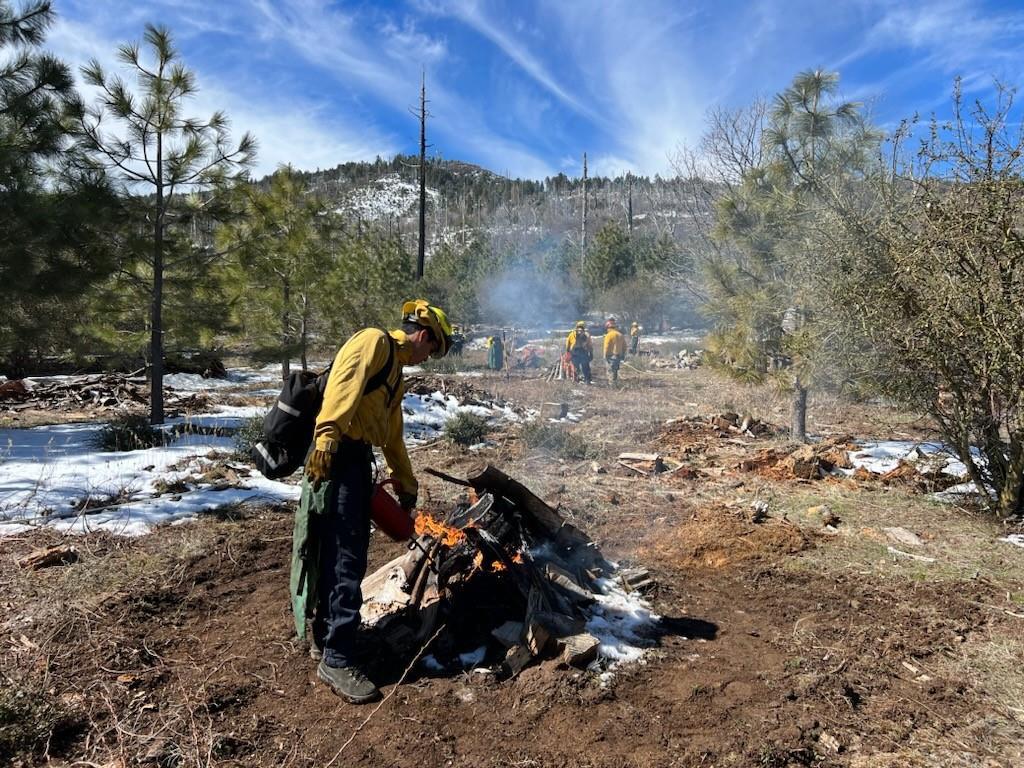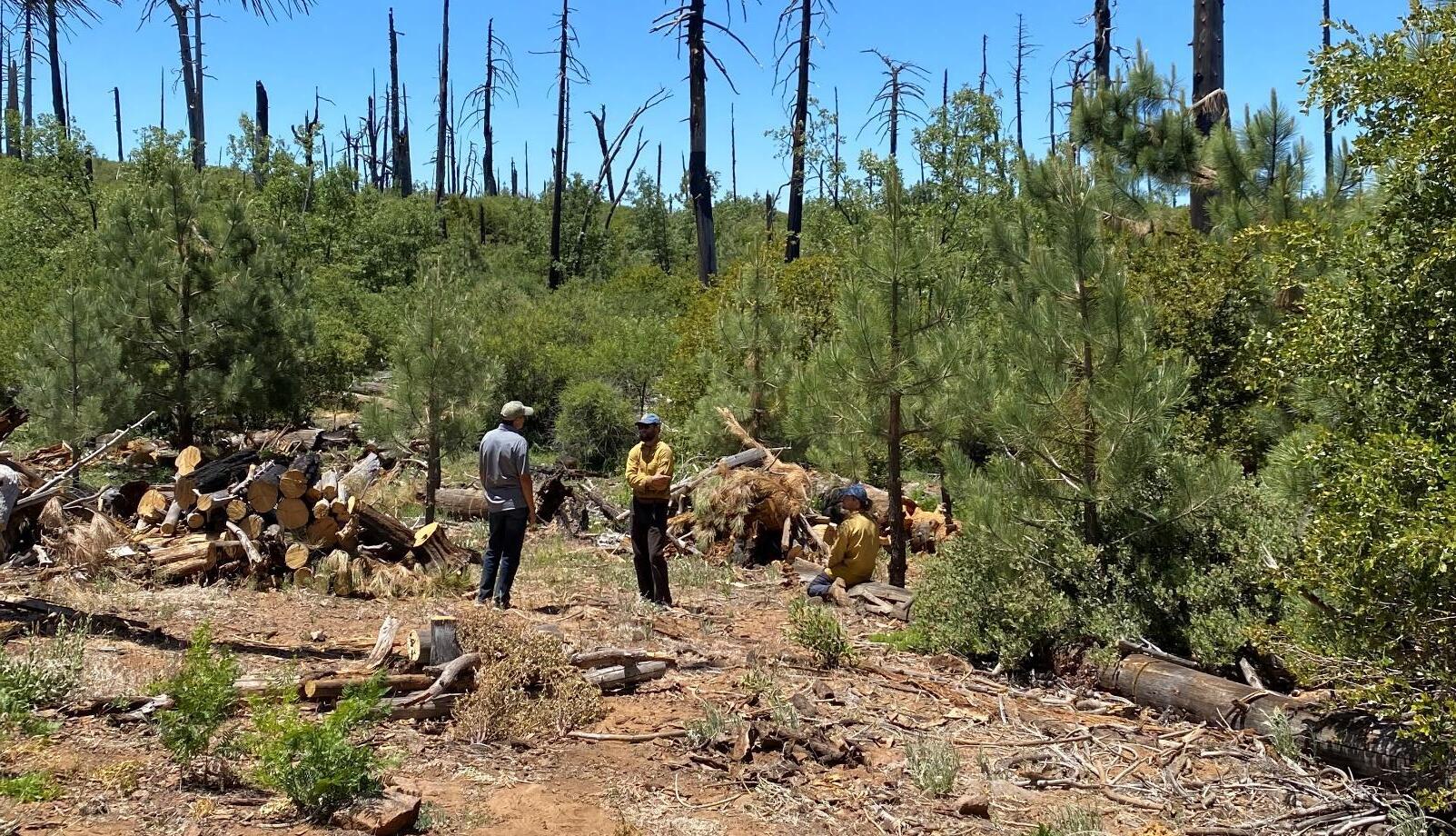Native American Conservation Corps Pilot Program





The Native American Conservation Corps (NACC) Pilot Program was collaboratively developed in San Diego County in 2021 to address regional wildfire resilience by providing workforce development opportunities to local tribal youth. The program aimed to provide paid on-thejob training to prepare participants for forestry and fire professions, to share traditional ecological knowledge, and to help increase cultural burning across the region
The original collaborative group included the San Diego River Conservancy, the Resource Conservation District of Greater San Diego County, CA State Parks Colorado Desert District, Kumeyaay Diegueño Land Conservancy, and local Native American tribes. Participants received training and certification in chainsaw use, basic wildland fire, and first aid. They also increased their workforce skills, making successful conservation corps crew members ideal candidates for subsequent forestry and fire-related positions. This two-year pilot program also incorporated Traditional Ecological Knowledge (TEK) from Native American elders who shared traditional burning and sustainable land management practices with the participants. During their on-the-job training, the crew conducted fuels reduction work on State Park land, which also increased wildfire and forest resilience in San Diego County.
Resource Conservation District of Greater San Diego County (RCDGSDC) utilized granted funds from San Diego River Conservancy through agreement #SDRG-B21-02 and California Natural Resources Agency, RFFC Program agreement #F32291 to support the pilot program with planning and coordinating logistics, purchasing supplies and equipment, and managing stipends.
This final report outlines successes, challenges, and lessons learned during this pilot program from the perspective of one project partner- Resource Conservation District of Greater San Diego County (RCDGSDC).
State Parks and RCDGSDC collaborated on outreach and recruitment, first finalizing a training calendar for each cohort, and then conducting community outreach and onboarding. The program successfully administered two sessions or cohorts of the training program, the first from November 2021- June 2022, and the second started January 2023 and is continuing as of the end of this funding in April 2023.
Outreach for recruitment was conducted primarily at cultural events, through previously established tribal contacts, and through online postings. Commitment was solidified though a hiring process, onboarding participants as State Parks Volunteers. The first cohort of the crew consisted of 7 crew members, 1 crew lead, and 2 additional hires for support staff, surpassing

the goal of 9 initial recruits. The second cohort consists of 5 crew members, 1 crew lead, and 2 support staff who remained with the program. RCDGSDC tracked daily participation and issued stipends efficiently and effectively.

RCDGSDC purchased and facilitated delivery and repairs for all necessary supplies and equipment for the program, including PPE, tools, field supplies, fuel, vehicles, etc. This was especially appreciated by State Parks staff, as they often experience long delays and supply chain issues with their own procurement processes. The original scope of work and budget detailed the items that we would need to outfit the crew for a successful tenure. Due to the diligence and resourcefulness of all involved, the crew was well equipped and we were under budget in this category.
We had a strong collaborative group from the beginning, but as the program developed, the partnership opportunities did as well!

Prior to beginning work in the field, participants attended two weeks of safety and basic wildland fire training. Several local partners, such as the American Red Cross, CAL FIRE, Climate Science Alliance Tribal Fuels Cadre, US Forest Service, and Cahuilla Tribal Fire Department collaborated with State Parks staff to provide these trainings. In addition to the initial training and on-the-job experience, participants also received training in Traditional Ecological Knowledge (TEK) from various cultural educators, chainsaw use in wilderness certification, basic first aid and CPR, native and invasive plant Identification, and GPS training (with programs such as Avenza and Collector). They also gained skills in navigating job posting and the job application process using resources such as CalCareers. Having completed their program, these local youth are prepared to enter the workforce either within their tribal communities or with a state or federal agency. Regional collaborations allowed for robust and meaningful training offerings. One outcome of the growing support of the program was the opportunity to participate in already planned training sessions in the region, again allowing us to meet our goals and come in under budget in this category, while also strengthening our community relationships.
Like other conservation corps programs, participants of the first session worked 8-day spikes, camped near the work site, and were provided with a stipend at the end of each spike. This type of immersive experience had several unforeseen issues such as weather and the individuals’ lack of presence in their communities while they were on spikes. We learned from our experience in the first session and modified the second session to have a different schedule.
In the second session, participants worked 4-day work weeks, Monday through Thursday with 10-hour shifts, and were provided bi-weekly stipends. This new schedule allowed participants to still be present in their family homes and their communities, and this improved the culture of the team.

The original scope of work included purchasing vehicles that would be retained by State Parks. We learned that their fleet policies would not allow for them to add or change vehicles in the fleet, so we needed to find a solution that allowed the crew to still have the transportation resources it needed. We rented fleet trucks for both crews, which we found to be efficient and more cost-effective.
Our grant agreement with SDRC was amended, which ended the contract earlier than anticipated and caused our work plan for the second session to be cut short by one month. It was important to RCDGSDC to fulfil its commitment to the participants of the session so that they could finish the program, so we sourced additional funding to complete the session with the current cohort.
As grant funding for the initial pilot program has ended as of April 30, 2023, we are working to continue and evolve the program. The second cohort of the crew will continue working through May, and possibly through June 2023 with financial support from CA State Parks and RCDGSDC’s leveraging grants. We are also looking at lining up work for the crew on tribal lands. As we continue the program, we will draw on our learning from the first pilot sessions as well as participant feedback, and we look forward to continued collaboration to build on the success of the program.

We heard from participants that the training was intense and hard work, and for many, it was their first experience with having the responsibility of being at work, on time and when scheduled. Many discovered passions they were not aware of and plan to take their new skills back to their tribal communities or pursue other new activities such as further education and travel. In addition, one participant was offered a job at their tribal fire department as a fire fighter, one was offered a position on a USFS fire crew, and three others were offered jobs with a local fuels reduction crew.
RCDGSDC is grateful for the San Diego River Conservancy's support of this program, and the positive impact it has had on local youth and the landscape.
“Many discovered passions they were not aware of and plan to take their new skills back to their tribal communities”